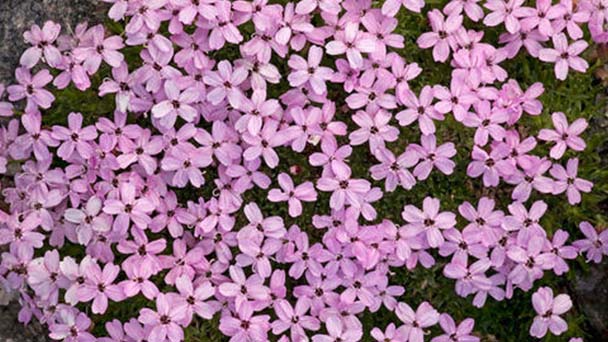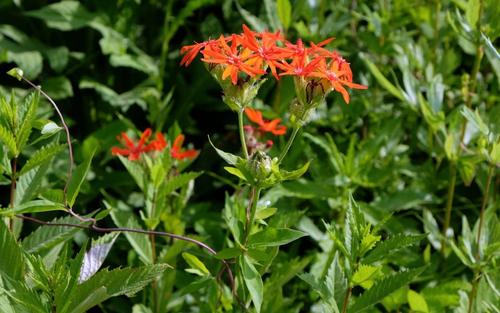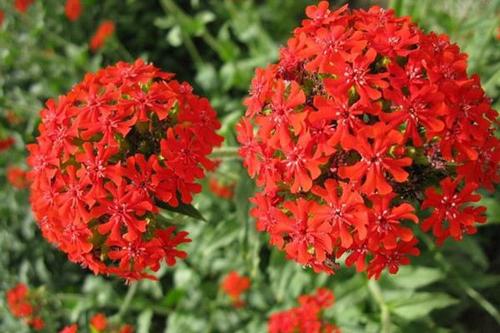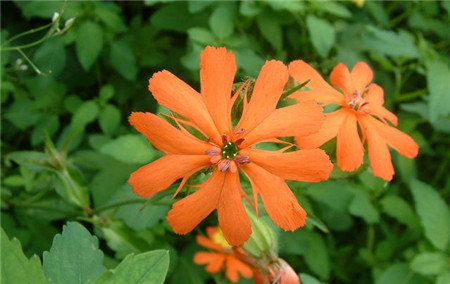Sweet orange (Lychnis cognata) profile
Written by Maggie
Mar 08 2021

Sweet orange, Lychnis cognata, Sweet Orange Catchfly, is a perennial herb in the genus Sweet orange and Dianthus family. Sweet orange height is about 60cm, the whole plant is dense with fine hairs. Leaves are opposite, ovate-lanceolate or ovate-elliptic, slightly phimosis, base leaves have short stalk, margin densely toothed. Flowers has 1-7 apex cymes, petals 5, dark red; Sweet orange has 10 calyx, apical 5 lobed. Sweet orange has 10 stamens, short to petals on pair, ovary clavate, style 5. Capsule is long holding shape, 5 teeth fissure, longer than the persistent calyx; Seeds are small, kidney - shaped, black - brown.
Sweet orange picture

Morphological characteristics of Sweet orange
Branch
Sweet orange is a perennial herb, 50-80 cm tall, the whole plant is pilose. Roots are fascicled, fusiform, slightly fleshy. Stem is erect, unbranched or distally branched.
Leaf
Leaf blade of Sweet orange is ovate-oblong or ovate-lanceolate, 4 -- 10 cm long and 2 -- 4 cm wide, rounded at base, sparsely wide cuneate, not stipitate, apically acuminate, coarsely hairy on both sides and margins.
Flowers
Inflorescences of Sweet orange are dichasium with several flowers, few with many flowers, compact corymbiform; Flowers are 3.5 -- 5 cm in diameter, pedicels 3 -- 12 mm long; Bracts are ovate-lanceolate, herbaceous, densely pilose and ciliate; Calyx is cylindric, 15 -- 20 mm long, 3 -- 3.5 cm in diam., late distally puberulent, thinly white villous, densely along veins, calyx teeth triangular, apex acute; Stamen stalk ca. is 5 mm; Petals of Sweet orange are dark red, claws not exposing calyx, narrowly lanceolate, ciliate, segments obovate in outline, 2-lobed to 1/2 of segments, lobes elliptic, sometimes apically toothed, with 1 linear lobule in middle and lower parts of each lobe; Corolla is long elliptic, dark red, fimbriate; Stamens of Sweet orange are slightly exserted, filaments glabrous.
Fruit
Capsule of Sweet orange is long elliptic ovate, 12-14 mm long; Seeds are kidney - shaped, about 1.2 mm long, hypertrophic, black - brown, with lactic convex.
The ecological habits of sweet orange
Sweet orange has little shade tolerance. Sweet orange still smells Sweet after it has withered. Unlike other flowers, it only smells Sweet when it is open. So in English, its meaning is supreme and unmatched.
Sweet orange's propagation
Sweet orange is mainly propagated by dividing plants and can be carried out in spring and autumn. The root is easy to break when dividing the plant, so the broken root can be rooted. Sowing can be carried out in spring and autumn, mainly in autumn, and the suitable temperature for seed germination is 20 degrees.
Variety classification of sweet orange
About 35 species of Sweet Orange belong to the same genus, which are distributed from the northern temperate zone to the Arctic. There are 10 kinds in our country. Common cultivated species are:
1. Sweet Orange (Lychnis Fulgens)
Short-lived perennial herbs. Plant height 50--80cm, the whole plant is long pilose. Leaves opposite, sessile, leaves ovate-oblong or ovate-lanceolate. Stem erect, single rod slightly branched at upper end. Cymes, petals 5, apex 2-lobed, apically slightly serrate, dark bright red. Capsule long ovate, top 5 teeth crack. In the elevation of 400-2000 meters under the forest, forest edge between the shrub and damp ditch edge. Cold resistance, like cool and humid, avoids hot and rainy. Originated in Northeast China, North China. The former Soviet Union, Korea, Japan also have distribution. For ornamental flowers.
2. Sweet Orange (Lychnis Wilfordii (Regel) Maxim)
Herbs perennial, 45-125 cm tall, plants glabrous or sparsely hairy. Roots slender, with many fibrous roots. Stem erect, simple, base rounded, distally angulate, hollow.Leaves oblong-lanceolate or oblong, 3-12 cm long, 1-2.5 cm wide, base taperate, slightly apiculate, apex acuminate to long acuminate, both surfaces glabrous, margin very short hispid.Flowers are usually 7-20 or more collected from the apex of the stem, forming a more dense dichafidum; Pedicels 3 -- 22 mm long, pubescent, base each with 2 linear lanceolate or lanceolate bracteoles; Calyx cylindric, clavate, 1.5 -- 2 cm long, with 10 veins, usually glabrous, calyx teeth triangular, acute, margin membranous, slightly pubescent, postanthesis calyx enlarged (especially distal part of calyx); Stamen stalk 4-5 mm long; Flowers 2.5-3 cm in diameter, 5 petals, bright red, up to 3 cm long, narrowly cuneate, lacerate, lobes linear, apex apiculate, with 1 filamentous lobes on each side, paw and calyx equal length, pale in color, with 2 oblong dark red scaly appendages between claws and petals; Stamens of 10, longer in pairs with petals, shorter in pairs with petals; Ovary oblong, style 5, slender.Capsule long ovate, apical, teeth split, teeth anti - curling;Seeds round kidney - shaped, black - brown after maturity, about 1 mm long, on both sides of the surface is densely wart-like process, the back is densely small thorns. On wet grass, water, river wetland, forest margin and undergrowth. Distribution in China (northeast), Russia (far east), Korea (north), Japan.
3. Shallow Sweet Orange (Lychnis cognata Maxim)
Herbs perennial, 25-90 cm tall, entire plant sparsely covered with long, curved hairs. Roots numerous, fleshy, fusiform.Stem erect, simple or distally branched, base rounded, distally slightly angulate, hollow. Leaves sessile or shortly sessile;Leaf blade oblong-lanceolate, oblong or oblong-ovate, 3 -- 11 cm long, 1.5 -- 4.5 cm wide, base cuneate or oblong-cuneate, apex acuminate, margin and veins more densely hirsute, both surfaces sparsely hirsute.3 -- 5(7) flowers clustered at stem apex into a corymus or cyme, or solitary in upper leaf axils, base with 2 bracts; Bracts leavy, lanceolate, hairy, pedicels 0.5-1.2 cm long, pubescent;Calyx tubular sticks, 2-3 cm long, with 10 of arteries and veins, glabrous or or thin thin hair, calyx teeth triangular, lancet, upper flower after enlargement, petals 5, orange red or reddish, 2 shallow crack or slightly concave, apex with serrate or entire, base on both sides each have 1 filamentous lobule, radical length or slightly longer than calyx, claw and the disc piece 2 scaly appendages, dark red, slightly thick; Stamens 10, short to petals on pair, ovary clavate, style 5. Capsule long ovate, 5 lobes, lobes apex anti - curling. Seeds round kidney - shaped, black - brown when ripe, the surface is warty. Born in the edge of the forest grassland, thickets, gully road and grass. Distribution in China's northeast, north China, North Korea (north), Russia (far east zone), etc.
4. Sweet Orange (Lychnis Chalcedonica L.)
Herbs perennial, 60-90 cm tall, pilose throughout. Leaves simple opposite, entire, sessile, ovate to lanceolate, parallel veins, basal leaves, 5 -- 10 cm long.Florets 10 -- 50 densely borne on stems forming cymes; Stem to 1.5cm, bright red or brick red. Originally in northern Russia and northwestern China, growing in woodland and small shrubs. The sex is cold resistant, like fertile not to bear infertile, the requirement is well drained soil. Bright colors, flowering coincides with the off-season at the turn of spring and summer, is the configuration of flower beds, flower borders, embellish the good material of rock garden. Can also be used as cut flowers, potted plants.
5. The hair strand [L.c oronaria (l.) Desr.]
Short-lived perennial herbs.Plant height to 100cm, much branched, densely white villi.Flowers solitary pedicel apex bright red. About 2.5cm in diameter, there are cultivated varieties of different colors. Native to northwest Africa, southeast Europe to central Asia. Avoid high temperature, waterlogging, summer hot and humid areas for biennial flower cultivation.

6. Unisexual Sweet Orange (L.Dioica L.)
Herbs biennial or short-lived perennial. Plant height to 90cm, whole plant hairy. Basal leaves obovate, 20cm long, long stipitate. Cauline leaves ovate, 10cm long, shortly stipitate. Flowers purplish red or pink. Open during the day, fragrance-free.Originating in Europe and spreading naturally to eastern North America.
7. German Silene (L. Vescaria L.)
Plant height of 40-90 cm.Leaves linear, smooth glabrous. Flowers purplish red, 2cm in diameter, double and white. Native to England, Spain, Turkey, Siberia to central Asia.
The distribution of sweet orange
Habitat: Forest margins, forests, valley grassy slopes, hillsides, grassy hillsides, sparse forest
Overseas distribution: Japan
Domestic distribution: Shanxi, Shaanxi, Gansu, Jiangsu, Anhui, Shanghai, Zhejiang, Jiangxi, Henan, Hubei, Hunan, Chongqing, Sichuan, Yunnan,
Originating in China and Japan. In China, there are wild mountains, hills and open forests in southern Jiangsu Province.Shaanxi, Sichuan, Hubei, Zhejiang and other provinces are distributed. Sweet orange was born in the edge of the forest grassland, thickets, gully road and grass.
Garden use of sweet orange
Garden is mostly used in flower beds, flower border configuration, Sweet orange is an excellent plant material in the rock garden; Sweet orange also is suitable for potted and cut flowers.

Latest Updated
- Benefits of Bugleweed - 7 Science-backed Health Benefits
- Bugleweed Dangers & Side Effects - Is It Poisonous?
- How to Plant Evergreen Trees - What You Should Know
- When to Plant Evergreens - Grow Guide for Evergreen Trees
- 12 Wonderful Evergreen Shrubs for Your Garden
- 12 Popular Evergreen Plants with Pictures for Beginners
- When And How To Prune A Lilac Bush Like a Pro
- How to Grow & Care for Lilac Vine (Hardenbergia Violacea)
- Japanese Lilac Tree (Syringa Reticulata) Care & Propagation Guide
- Shumard Oak Pros and Cons - What to Know
Popular Articles
- Winter maintenance of Antirrhinum Majus
- How to Grow Terminalia Mantaly Tree
- How to Grow and Care for Crossostephium Chinense
- How to grow Antirrhinum Majus in spring
- Peristeria Elata (Dove Orchid) Profile: Info & Care Guide
- Underwatered Snake Plant (Sansevieria Trifasciata) - Signs And How To Fix
- How to Care for Brazilian Jasmine Plant (Mandevilla Sanderi)
- How to Grow & Care for Graptopetalum Purple Delight in Summer
- Rosa Chinensis (China Rose): Plant Growing & Care Tips
- How to Care for Baby Sun Rose (Aptenia Cordifolia)